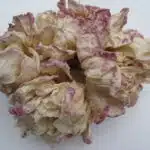Roses are an iconic symbol of beauty and elegance, gracing gardens and landscapes around the world. Growing roses in pots is a great way to cultivate this classic flower for your own pleasure, or to give as gifts. It’s also a great option for gardeners with limited space who don’t have the room for a garden bed. As a specialist in botany and gardening, I am here to help you get started growing roses in pots.
In this article, I will share my tips and tricks on how to grow lush, healthy roses in containers. From selecting the right potting mix and choosing the right pot size to providing proper care throughout the season, I will provide all the information you need to successfully grow beautiful potted roses. With just a little time and effort, you can enjoy these timeless blooms in your own home or garden!
Whether you’re an experienced gardener looking to add some color to your patio or balcony, or just getting started with container gardening; growing roses in pots is an easy and rewarding experience that anyone can do! Let me show you how!
Choosing The Right Pot
When it comes to growing roses in a pot, the first step is choosing the right pot. A good container should be at least 12 inches deep and 18 inches wide. This will give the roots of your rose bush enough space to spread out and thrive. It is also important to choose a pot that has drainage holes in the bottom so that excess water can escape and not drown your plant. Additionally, make sure you use a container with thick walls as this will help insulate your rose bush from extreme temperatures.
In order for roses in pots to be healthy and strong, they need plenty of nutrients. This means preparing the right potting mix. It should be loose enough for air circulation and contain good quality compost or manure, along with some well-rotted organic material like leaf mold or sawdust. Also, adding some slow-release fertilizer can provide your roses with additional food over time.
Ultimately, when it comes to growing roses in pots, the two most important steps are selecting an appropriate container and creating a nutrient-rich potting mix. With these two elements taken care of, you can give your rose bush everything it needs to grow strong and beautiful for years to come! Ready for the next step? Preparing the potting mix is essential for fertilizing rose bushes in containers.
Preparing The Potting Mix
Ah, the sweet scent of roses! Growing roses in pots is a rewarding experience for any gardener. After choosing the right pot for your rose, it’s time to prepare the potting mix; a vital step in ensuring healthy and vibrant blooms all season.
When preparing the potting mix, you’ll want to ensure it has plenty of organic matter. This will help the soil retain moisture and provide essential nutrients to your rose. A good mixture usually consists of two parts peat moss, one part compost, and one part vermiculite or perlite. Adding a slow-release fertilizer to this blend can also be beneficial for your rose’s growth and development.
To make sure that your potting mix drains properly, add some pumice or gravel to the bottom of your container before adding the potting mix. This allows excess water to easily escape from the pot, which will help prevent root rot and other issues with your rose bush. It’s also important to keep an eye on water levels as you don’t want too much or too little – both can lead to stunted growth or even death of your plant.
Now that you have everything ready, it’s time to think about planting those beautiful roses!
Planting The Rose
With the proper care and attention, you can successfully grow roses in pots! In fact, according to a study conducted by the American Rose Society, more than half of all rose varieties can be grown in containers. Now that you have chosen your desired potting mix, it’s time to plant your rose!
The process for planting a rose in a pot is relatively straightforward. Start by filling the pot with soil – use enough soil that there is an inch or two of space between the top of the soil and the top of the container. Place your rooted rose cutting into the center of the pot and gently press down on it until it sits firmly against the surface of the soil. Add additional soil around and over the root ball so that they are completely covered. Water thoroughly to help settle any air pockets in the soil.
Once planted, mulch around your rose bush with organic material such as bark chips or grass clippings to help keep moisture levels consistent and protect against weeds. This will also give your potted rose an attractive appearance. With some regular watering and fertilizing, you can ensure that your potted rose stays healthy and blooms beautifully!
Watering And Fertilizing The Rose
Watering and fertilizing the rose is key to its growth and health. A healthy, flourishing rose requires frequent watering and regular fertilizing. As a specialist in botany and gardening, I recommend adhering to specific watering and fertilizing guidelines for optimal results.
First, it’s essential to keep the soil moist but not soggy; water should be applied regularly, allowing the soil to dry between waterings. Rainfall can provide sufficient hydration if the pot is placed outside, however if needed, supplement with regular waterings. Additionally, during the growing season feed your roses with a balanced fertilizer every two weeks or so for best results.
Finally, one should be mindful of overwatering which can lead to root rot or other ailments. Furthermore, ensure that fertilizer isn’t applied too close to the stem or foliage of the plant as this can cause damage. With careful attention to both watering and fertilization practices your rose will thrive in its new container home!
Pruning The Rose
As the sun warms the air and the petals of the rose bloom, a gardener can’t help but admire their beauty. But what many don’t realize is that to maintain this beauty, they must also prune their roses. Pruning is an essential part of a rose’s care and maintenance routine, as it helps to promote healthy growth and flowering.
As any experienced rose grower knows, proper pruning techniques are key when keeping roses in pots. To begin, remove all dead or diseased canes, as these can be damaging to other parts of your plant. Also, ensure that you’re cutting back any crossing branches and thinning out congested growth. This will allow air to flow freely throughout the plant which is essential for growth and development. Additionally, if you’ve just planted your rose bush in a pot or container, you should wait until it has had some time to establish itself before you start pruning it.
Finally, be sure that you’re using sharp garden shears or bypass pruners when trimming your rose bush back. This will prevent any damage from occurring and ensure that your roses look their best! With proper pruning techniques and regular care and maintenance, your potted roses will remain beautiful for years to come.
Providing Shade And Sun Protection
It is estimated that up to 40 percent of novice gardeners will struggle with protecting and shading their roses in pots from the sun. Providing shade and sun protection for your roses can help them grow healthy and strong. Here are a few tips you can use to protect your rose plants from the sun:
Choose an area that receives partial sunlight, such as a spot near an east-facing window or wall, for optimal protection from the harsh midday sun.
Utilize outdoor umbrellas to create a shady area during hot summer days and when direct sunlight could cause damage to your roses.
Place a breathable fabric or other material over the potting container on sunny days to provide additional shade for your roses while allowing air circulation.
If you’re looking for ways to improve the health of your roses, providing adequate shade and sun protection is essential. Not only will it reduce the risk of wilting and burning, but it also encourages healthier blooms throughout the growing season. When selecting a spot for your rose containers, choose one that is in partial shade or receives filtered sunlight most of the day – this will keep them safe from scorching temperatures while still receiving enough light to stay healthy and vibrant. Additionally, consider using outdoor umbrellas or breathable fabrics for added protection on especially hot days or when direct sunlight becomes too intense for your roses. By following these simple steps, you’ll be well on your way to cultivating beautiful blooms in no time!
Controlling Insects And Diseases
Controlling insects and diseases is a delicate art, much like dancing between two partners in perfect unison. As the botanist, it’s your job to ensure that your roses are not only healthy and vibrant, but also free from pests and disease. Thus, you must take proactive steps to keep the garden safe.
To begin with, make sure all plants are inspected regularly for signs of an infestation or disease. Regularly remove all fallen leaves and debris as this is where many pests live and feed. The same goes for pruned stems; these should be removed immediately after pruning as they can harbor harmful pathogens. Also, keep weeds away from the rose bushes as they too can have negative impacts on the health of the plants.
It’s also important to use organic pesticides whenever possible as conventional chemical treatments can be hazardous to both humans and animals alike. Only use organic treatments when necessary and always follow directions carefully when applying them. Additionally, be sure to look for natural predators such as ladybugs which can help control pest populations naturally without harming other beneficial insects or pollinators in the process.
Taking these proactive steps will go a long way towards keeping your roses healthy and beautiful for years to come. Adopting good gardening practices will ensure your roses thrive even in less than ideal conditions – making them a wonderful addition to any outdoor space!
Deadheading And Disbudding The Rose
Deadheading and disbudding are important steps in growing roses in pots. Deadheading, or the removal of spent flowers, stimulates new growth and prevents the plant from expending energy on developing seeds. Disbudding is the process of removing all but one bud from a stem. This encourages larger, more plentiful blooms. For both deadheading and disbudding, use sharp garden shears or pruners to cut just above an outward-facing bud at a 45° angle.
When deadheading, also be sure to cut away any weak and unhealthy stems as this will help keep your rosebush healthy and productive. Additionally, pruning can help improve air circulation within the plant – allowing light and air to reach all areas of the bush – and reduce disease pressure. Prune back the longest canes by one-third to open up the center of the bush, which will encourage new growth.
It’s essential to provide your roses with regular care throughout their life cycle in order to ensure their continued health and vigor. With proper maintenance, you’ll be rewarded with an abundance of beautiful blooms for years to come! With that in mind, it’s time to select the best variety of rose for containers so that you can get started on your own rose garden!
Selecting The Best Variety Of Rose For Containers
The selection of the best variety of rose for containers is perhaps the ultimate irony; one might think that any rose variety would do in a pot, but nothing could be further from the truth. In reality, choosing the correct rose variety for pots requires careful consideration and an understanding of the needs of roses and their growing environment. As a specialist in botany and gardening, I can assure you that selecting the right variety is essential to ensuring healthy growth and abundant blooms.
When selecting roses for containers, it’s important to look at their overall characteristics such as size, disease resistance, cold hardiness, bloom timing and color. Different varieties will thrive in certain conditions more than others; for instance, if you live in an area with colder winters, then you’ll want to choose a variety that can withstand temperatures below freezing. Additionally, consider the amount of sun exposure your roses will receive; some varieties prefer full sun while others do better in partial shade. Lastly, think about how large your container is; some varieties have larger root systems and require larger pots than others.
By taking all these factors into consideration when choosing your rose variety for pots, you can ensure that your plants will thrive and give you many years of beautiful blooms. With this knowledge under our belts, let us now turn our attention to winter care for roses in pots – a topic just as essential as selecting the right kind!
Winter Care For Roses In Pots
As a Specialist in botany and gardening, I’m here to help you understand the winter care for roses in pots. It’s important that you give your roses the best chance of surviving the cold season with proper winter preparation.
First, it’s essential to make sure your potted roses are well-sheltered from the harsh winter weather. Place them in an area that is protected from strong winds, or position them against a wall or fence where they can be partially shaded by trees and shrubs. Additionally, mulching around the roots will help keep them warm and insulated during freezing temperatures.
And when it comes to watering, don’t forget that roses need much less water in winter than they do during summer months. If there’s no rain or snowfall, aim to water every two weeks – but only if the soil feels dry to touch. Overwatering can increase their susceptibility to disease and rot, so err on the side of caution when it comes to hydration during this time.
These simple steps should ensure your potted roses remain healthy throughout winter – but there are other challenges too which we’ll explore next.
Common Challenges With Growing Roses In Containers
Growing roses in containers can be a rewarding experience, but it also poses some common challenges. According to the American Rose Society, more than half of all roses grown are container-grown. This statistic illustrates the popularity of growing roses in pots and shows that even beginners can have success with this type of gardening.
When growing roses in containers, these are some of the most common issues you should look out for: • Poor drainage – If your pot doesn’t have enough drainage holes, the roots can become waterlogged and rot, resulting in an unhealthy plant. • Overwatering – Too much water can lead to root rot and other problems, so make sure to check if the soil is dry before watering again. • Insufficient sunlight – Roses need at least six hours of direct sunlight each day to produce blooms, so make sure your pot is placed in a sunny spot. • Not enough nutrients – Container soil tends to be depleted faster than garden soil because of frequent watering and evaporation; therefore it’s important to add fertilizer every few weeks to ensure sufficient nutrients for your plants.
By recognizing these common challenges and taking steps like providing adequate drainage and ensuring adequate sun exposure, you can maximize blooms from your potted roses.
Maximizing Blooms In A Pot
It’s time to go beyond the basics and really get a handle on how to maximize blooms in a potted rose. If you’re ready to take it to the next level, here’s what you need to know. To borrow an idiom, you can’t expect roses without thorns – there are some challenges that come with this endeavor.
First of all, there is the matter of soil. Roses need rich soil with good drainage, so regular potting mixes likely won’t do the trick. You’ll want to use a special type for roses that includes slow-release fertilizers and extra organic material like compost or peat moss.
Then there’s the sun. Roses love bright light but not too much heat, so if your pot is in direct sunlight for more than six hours a day, it may be time to move it into some shade or indirect light. It’s also important to monitor water levels consistently – avoid overwatering as well as letting your plants dry out too much.
Finally, don’t forget about pruning and deadheading regularly – removing old blooms helps encourage new ones! As a dedicated botanist and gardener, I can promise that doing these simple tasks will help keep your potted roses looking beautiful all season long.
Moving Potted Roses
“A rose is a rose is a rose,” and it’s no surprise that roses are so popular. As beautiful as roses can be in the garden, you can also enjoy their beauty up close by growing them in pots. Moving potted roses is an essential part of caring for them, and if done correctly, will help ensure healthy blooms all season long.
When it comes to moving roses in pots, timing is everything. If possible, move your containers during periods of cooler weather such as early spring or late fall when temperatures are milder and the risk of transplant shock lessens. Choose a day with no wind and no rain; this will make it easier for the plants to acclimate to their new locations without further stress.
Before relocating your potted roses, be sure to water the plants thoroughly at least one day before moving them. This will help reduce any potential shock that may result from having their roots disturbed during transplanting. When you’re ready to move them, gently remove each plant from its pot before transferring into its new location. Be sure to fill in around the base of each plant with plenty of soil and compost mixture for optimal growth and health.
Moving potted roses should be done carefully and thoughtfully for best results; however, with proper timing and technique you can successfully maintain beautiful blooms year-round!
Growing Roses In A Hanging Basket
Growing roses in a hanging basket is a great way to add beauty and brighten up any space. Not only do they look beautiful, but they’re also relatively easy to maintain. Here are just a few tips to keep in mind when growing roses in hanging baskets:
First, use a lightweight potting mix with good drainage. This will help prevent the roots of the rose from becoming waterlogged, which can lead to root rot. Additionally, you’ll want to make sure you have plenty of organic matter mixed in with your soil mix. This will provide additional nutrients for the plant and help hold moisture.
Second, it’s important to choose a spot with full sun exposure for best results. Since these plants thrive on sunlight, making sure they get at least 6-8 hours of full sun per day is essential for blooming and flowering success. You should also make sure that your container has enough drainage holes so that water doesn’t become trapped in the soil and cause root rot.
Finally, regular pruning is key when it comes to keeping your roses healthy and looking their best. Pruning helps encourage bushy growth and encourages more blooms throughout the season. You should also fertilize regularly every two weeks or so during the growing season, as well as deadhead spent blooms regularly as well. With these simple tips in mind, you’ll be able to enjoy beautiful roses grown in hanging baskets all season long!
These steps will give you a strong foundation for successfully growing roses in pots—but there are still more tips and tricks that can help ensure your success!
Growing Roses In Pots: Tips And Tricks
Gardening is a skill that has been around since the dawn of time, and roses are some of the most beloved flowers in existence. Growing roses in pots is an art form, but with a few tips and tricks, even novice gardeners can learn how to make it successful.
Let me start by alluding to the experts of yore – they knew how to cultivate roses in their gardens and make them thrive. Nowadays, growing roses in pots can be a daunting task for beginners, but it isn’t impossible. With proper knowledge and preparation, anyone can learn how to grow beautiful roses in containers.
When planting roses in pots, paying attention to several factors is key to success. Firstly, you should select a pot that’s large enough for the type of rose you’re growing – too small a pot will limit growth and cause root suffocation. Secondly, use quality soil for optimal drainage; don’t forget about fertilizers either! Finally, keep an eye on the water levels; too much or too little water can stunt your plants’ growth.
With care and dedication, even amateurs can achieve gorgeous blooms from potted roses. All you need is patience and dedication – soon enough you’ll have blooming buds sprouting up from your pots!
Frequently Asked Questions
What Is The Best Size Pot For Growing Roses In?
When it comes to growing roses in pots, size matters. The best size pot for a healthy, thriving rose bush is one that is large enough to hold the root system of the plant and provide adequate drainage. It’s important to select a pot that is not too big or too small for your rosebush.
Large pots are ideal for roses since they promote good root growth, which helps with nutrient absorption and overall plant health. A pot that’s at least 16 inches deep and 18 inches wide will provide plenty of room for a rose bush to grow and flourish. Furthermore, larger pots are advantageous because they tend to retain moisture better than smaller containers and require less frequent watering.
Selecting the right material for your pot is also an important factor when planting roses. Clay or terracotta pots are great options because they allow air to penetrate through their walls, providing additional oxygen to the plant’s roots and helping them stay healthy. Plastic pots can be used as well, but should be monitored closely as they don’t allow as much air circulation as clay containers do.
In addition to choosing the right size pot and material, ensuring adequate drainage is key when growing any type of plant in a container. Making sure there are several holes in the bottom of your pot will help keep the soil from becoming overly saturated with water and prevent root rot. So, take these considerations into account when selecting a container for your rose bush – it will help ensure its success!
How Often Should I Fertilize My Potted Roses?
Fertilizing your potted roses is an important part of ensuring they grow strong and healthy. Roses grown in containers require frequent feedings, particularly during the warm summer months when they are actively growing. The best way to determine how often to fertilize your plants is to consider the type of fertilizer you are using and its recommended application instructions.
Organic fertilizers like compost or manure, for example, can be applied every few weeks or as needed throughout the growing season. These fertilizers release their nutrients slowly over time, so it’s a good idea to use them consistently throughout the season. On the other hand, synthetic fertilizers with readily available nutrients usually need to be applied more often — typically once a month or every few weeks during peak growth periods.
It’s also important to take into account the age and size of your roses when determining how often to fertilize them. Young roses will benefit from more frequent feedings than mature ones, while larger plants may require less frequent applications than smaller ones. For best results, experiment with different feeding schedules until you find one that works best for your roses.
Is It Necessary To Prune My Roses In Pots?
Pruning your potted roses is an important part of their care. Roses are vigorous growers, and if left unchecked, can quickly become overgrown and ungainly. Pruning also helps to promote new growth and abundant flowering. Knowing when and how to prune is essential for a successful rose gardening experience.
Pruning should take place in late winter or early spring, just before the growing season begins. This will help to encourage strong growth in the coming year. When pruning, remove any dead or diseased wood, as well as any crossing branches that might be competing with each other for light and space. Also remove any weak shoots that won’t bear flowers or fruit. Be sure to leave at least three to five healthy buds per stem so that your rose bush remains full and blooms abundantly in the upcoming season.
It’s important not to prune too aggressively as this can lead to reduced flowering, so it’s best to start conservatively and only remove what you think is necessary. If you’re unsure where to begin, it’s helpful to consult a professional or read up on the basics of pruning roses before getting started.
TIP: Always use sharp garden shears when pruning your roses—dull blades can tear the stems instead of making a clean cut, which can damage the plant and make it more susceptible to disease.
Are There Specific Varieties Of Roses That Are Best For Growing In Containers?
Do you want to grow beautiful, fragrant roses in containers? Then you’ve come to the right place! Container gardening with roses is a great way to bring vibrant colour and scent into your outdoor space. But how do you go about it? Are there specific varieties of roses that are best for growing in containers?
The answer is yes! Depending on the size and shape of your container, there are several different types of roses that will thrive in a pot or other container. Hybrid teas and floribundas are both popular choices for container gardening. These two classes of roses tend to bloom heavily throughout the summer months, making them ideal for adding beauty to small spaces.
When selecting a variety of rose for your container garden, look out for disease resistance as well as good fragrance. Some varieties have an added bonus: they’ll also tolerate partial shade, so if you don’t get full sun in the spot where you’re planting your pot – don’t worry! Here are some recommended varieties that will work well in containers: • ‘Carefree Beauty’ Hybrid Tea Rose • ‘Iceberg’ Floribunda • ‘Graham Thomas’ Shrub Rose
Remember that when planting roses in pots, it’s important to choose a well-draining soil mix and make sure the pot has ample drainage holes. You should also keep an eye on moisture levels; since these plants are enclosed in pots, they will dry out more quickly than ones planted directly in the ground. Finally, be sure to give your potted roses regular fertilizer throughout their growing season. With the right care and attention, you can enjoy beautiful blooms from your container garden all summer long!
How Do I Protect My Roses In Winter If They Are In Pots?
Ironically, roses in pots can be more vulnerable to the cold winter weather than roses in the ground. Without the insulating layer of soil around them, they are more exposed to frost and freezing temperatures. But there is no need to despair! With a few simple steps, you can protect your roses in winter if they are grown in containers.
As a specialist in botany and gardening, I would recommend starting by moving your potted rose plants into a sheltered spot. The best place is somewhere away from direct wind and any frost pockets – such as near a wall or fence – that will provide some extra protection from cold air. Additionally, wrapping the pot with bubble wrap or old blankets during extreme temperatures can also help keep your rose warm.
Finally, it is important to regularly check on your container roses throughout the winter months. Make sure that their soil is moist enough but not soggy; this helps prevent damage from any sudden drops in temperature. Also pay attention for signs of pests or disease; if left untreated these issues can weaken plants and make them more susceptible to cold weather damage. By taking these preventative measures, you can ensure that your roses stay healthy and beautiful all year round!
Conclusion
When it comes to growing roses in pots, the right pot size, fertilization schedule and pruning technique are all essential for the success of your potted rose garden. By selecting a pot that is big enough to accommodate your roses’ root system, providing regular fertilization and pruning as needed, you can create an environment where your roses will thrive. Additionally, some varieties of roses are better suited for container gardening than others. It is important to do your research before selecting a variety to make sure you provide them with the best possible conditions for growth. Finally, don’t forget to protect your potted roses during the winter months by providing them with extra insulation or bringing them indoors if temperatures get too low. With proper care and attention, even novice gardeners can grow beautiful roses in containers!





























